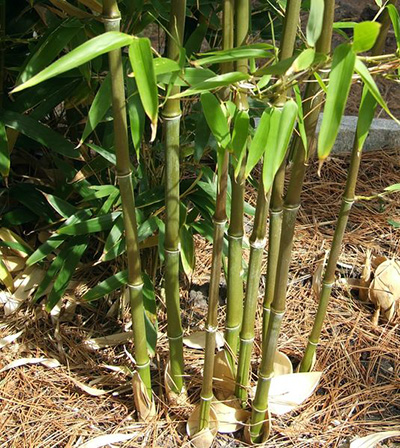Bamboo Planting Method
How to Grow Bamboo - Article Contents
![]() Become a fan of complete bamboo on Facebook!!
Become a fan of complete bamboo on Facebook!!
Become a fan on facebook and ask us questions about growing bamboo plants. You will get a bamboo expert's free answer within a couple of days!
Winter Timing
Planting your bamboo is the fun part of the process. This section is based on the assumption that the bamboo plant is currently in a container. The actual process of planting bamboo is similar to most other garden plants and trees, but there are a couple of unique factors to consider.
Timing – Timing is the first factor to consider before you start the planting process. Areas with mild climates, such as the US Pacific Coastline or Florida, can be planted at anytime throughout the year. For areas with more severe seasonal weather, timing will be critical. In colder regions, the goal is to allow the plant enough time to establish a root system and become hardy enough to survive in freezing winds, temperatures, and frost. Freezing winds are a young bamboo plant’s worst enemy. The cold temperatures are not particularly damaging, but the loss of moisture will cause plant to dry out quickly. For a young plant that is not well established, the aftermath of winter can be devastating. Frost can also be troublesome to a new plant. A consistent layer of frost has the potential to cause cell damage to the plant. Leaves are the most susceptible to frost, but the culms of a young plant are also at risk during its first winter. For most bamboos, you will need to plant at least 6 weeks before winter. This timeframe will depend on the harshness of your winters, as well as other type of bamboo being grown. The bottom line is that it is always best to plant in early spring, when there is the lowest chance of your bamboo being exposed to a combination of freezing temperatures and direct sunlight.
Bamboo Covered in Frost. (Photo: Kenneth Hawes)
Outdoors Planting Method
Dig the Hole - Start by digging a hole with the same depth as the container and about twice its width. The most common mistake bamboo growers make is to dig the hole too deep and too narrow. Planting bamboo too deep or narrow will inhibit the rhizomes ability to gather oxygen and nutrients. For optimum growth potential, create a mixture of 1 part soil and 1 part organic compost. It is generally advised to avoid using fertilizer or manure during the initial planting, which could potentially damage the rhizomes. High levels of nitrogen in a fertilizer can actually burn the young rhizomes. Another drawback of manure is that it is a source of weed seedlings. Manure and fertilizer will become more useful once the plant is well established. Depending on the type of soil, you may need to improve the drainage of the area. Keep in mind that, bamboos do not grow well in soggy or heavy soils. If you need to contain the spread of the rhizomes, it may be necessary to install a barrier. Check out the rhizome barrier article for more details on this step.
Fill the Hole – Take the soil mixture and fill the outer walls and bottom of the hole while still leaving enough room for the plant itself. Place the bamboo into the hole at about the same level as the surrounding material. Use the remainder of the soil compost mixture to fill in the space around the plant. Be extremely careful not to damage the roots of the plant which are very delicate and vulnerable at this stage. It is also important to avoid leaving any air pockets around the roots. Once the plant is secured in the hole, test the strength of the newly planted bamboo. It should be secured to the point at which winds will not be able to knock the plant over.
Initial Watering – Now that the bamboo has been given its new permanent home, it is time to water the area. Add a generous amount of water to the area and firm down the soil while doing so. This will give the bamboo additional strength. As a general rule of thumb, 1 gallon of water should be used for each 5 gallon container that was planted. After the initial watering, the bamboo should be watered 2-5 times per week. The frequency of watering will depend on the season and your local climate; warmer climates obviously needing more frequent watering. Bamboos like to dry out, so allow a couple days of spacing on the plants watering schedule.

Bamboo in Pine Needle Mulch. (Photo: Erin Silversmith)
Mulch – Bamboo will thrive best with a layer of mulch to protect the roots and rhizomes. Organic mulches are recommended for bamboo and can do wonders for promoting healthy growth. Mulch serves as protection from pests and weeds, while also retaining water and providing nutrients. Compost and dried leaves are the ideal choices. If you are already growing bamboo in your garden you can use leaves from the already plants. Grass is also a sufficient choice. Synthetic mulches will also work if appearance is a concern in your garden, but are not recommended.
